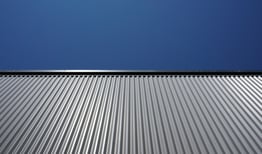Metal roofing continues to be the material of choice for many commercial building projects thanks to its durability, sustainability, ease of installation, fireproof character, and resistance to strong winds.
Despite the COVID-19 pandemic, the global metal roofing market is projected to grow at a 4.64 percent clip to $20.39 billion total by 2026, according to a report from Verified Market Research.
In addition to growing commercial and industrial construction, that report cites “ongoing renovations in building and improved manufacturing processes are fueling the growth of the Metal Roofing Market.”
Iconic Commercial Buildings Utilize Metal Roofing
Noted architect and engineering firm HOK has designed some iconic buildings including the Mercedes-Benz Stadium which utilized 27,500 tons of roof steel.
“When fabricated and installed correctly,” Steven Danielpour, AIA, principal and director of specifications at New York–based HOK, told Architect Magazine that metal roofs “can outlast and outperform elastomeric roof systems, SBS-modified [styrene butadiene styrene–modified] roof systems, and single-ply roofs.”
Principles of Metal Roofing for Commercial Buildings
When it comes to using steel for commercial building roofing the most common choices include:
- Steel which is typically galvanized or coated for protection.
- Aluminum which is typically painted or anodized for added resilience.
- Copper which offers an aesthetic patina.
- Zinc which offers corrosion resistance and has a low-gloss look.
Most commercial projects use metal roofing panels or sheets with a gauge that ranges anywhere from 3 to 30 with the higher the gauge, the lighter the total metal weight.
Insulated metal panels such as Green Span Profile’s RidgeLine are insulated standing-seam panels that slide easily together for installation thanks to a patented tee-seam.
The interior tongue-and-groove joint, coupled with a factory-caulked batten, provides a double layer of weather-tight protection, making it a popular choice for commercial buildings.
Benefits of Metal Roofing for Commercial Buildings
There are a lot of advantages to using metal roofing on commercial buildings with the top seven benefits as follows:
1. Durability and Longevity Lead to Reduced Costs
Metal roofing has a bit higher initial cost but saves money in the long run because of its durability, requiring less maintenance and repair, and its longevity. According to Kodiak Roofing & Waterproofing Co., metal roofing can last three times to six times longer than other type of roofing materials:
- Modified Bitumen, multi-ply roofing material: 10 to 20 years
- Tar and gravel, build-up roofing: 15 to 20 years
- PVC: 15 to 30 years
- Silicon: up to 20 years

- Asphalt: up to 20 years
- Thermoplastic (TPO) roofing: 20+ years
- Clay/concrete: up to 25 years
- Solar: 25+ years
- Wooden shakes: up to 30 years
- Slate: 50+ years
- Metal: 40 to 60 years
2. Lightweight but Strong
Metal roofs are strong yet weigh less than other roofing material, so they do not need any additional support for material such as tiles. McGraw-Hill found in a survey that 22 percent said strength was the primary reason for investing in a metal roof, second top reason behind 26 percent that cited its longevity. According to Metal Outlet various weight of roofing material:
- Metal: 40 to 120 pounds per square
- Wooden shakes: 200 to 300 pounds per square dry but 400 to 600 pounds wet
- Asphalt/fiberglass: 210 to 350 pounds per square
- Clay/concrete tiles: 800 to 1,000 pounds per square
3. Simple Installation
Metal roof installations are relatively straightforward and do not require a lot of heavy machinery. Metal roofs installation price, $225 to $300 a square, runs about half of clay/concrete tiles which can run $500 t0 $600 a square. Labor savings are achieved with IMPs which have built-in installation, saving construction time and expenses.
4. Fire Resistant
Metal roofs are fire-resistant, most qualifying for a Factory Mutual Class A firing rating. Unlike other types of roofing materials, such as asphalt, metal roofs are combustible. The threat of wildfires in the west and southwest – 57,000 wildfires in 2020 burned 10.3 million acres in 2020 – make metal roofs a safe choice.
5. Sustainability
Metal roofs are environmentally friendly. They are a sustainable option since they are manufactured partly with recycled material and are 100 percent recyclable at the end of their lifespan. Apart from going solar or installing a “living roof” with soil and plants, metal roofs are the best green option.
6. Energy Efficiency
Unlike some roofing materials that absorb the heat, metal roofs reflect the sun, making them energy efficient. A study by the U.S. Department of Energy and conducted by the Oak Ridge National Laboratory showed that metal roofs promote energy conservation. Some estimates have metal roofing saving up to 25 percent on cooling bills.
7. Weather Resistance
Metal roofs fare well in extreme weather, withstanding wind speeds over 110 miles per hour and be a frontline defense in hurricanes. They also perform well in heavy rain, freeze and thaw cycles and extreme heat. The Green Span Profile’s RidgeLine insulated metal roof panels have UL 580 Class 90 Approval for wind uplift as well as approval for installation over open framing by Florida’s building codes, demonstrating compliance with ASTM E 1592, ATM E84 and FM 4471.
Contact Green Span Profiles today to find out more how our state-of-the-art insulated metal panels can benefit your commercial building project.






